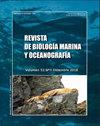作为海洋污染生物指示物的红藻:其代谢物和吸附污染物的研究进展
IF 0.5
4区 生物学
Q4 MARINE & FRESHWATER BIOLOGY
引用次数: 2
摘要
大型藻类被认为是海洋污染的生物指标,因为它们具有对环境变化做出快速反应的能力。因此,根据物种特征和适应策略,巨藻种群数量会波动。它们的细胞壁多糖含有能够保留和积累重金属的硫酸盐基团。除了传统污染物外,水生环境中的新兴污染物也得到了认识。在此,从巴西乌巴图巴福塔莱萨海滩收集的大型藻类Dichotomaria marginata解吸后,确定了新兴污染物。基于藻多糖网络具有与极性化合物形成氢键的潜力,假设这些污染物将与糖聚合物结合。采用气相色谱/质谱法(GC/MS)和液相色谱/质谱法(HPLC/MS),并辅以计算方法对边角草样品中的化合物进行鉴定。用GC/MS和HPLC/MS分别鉴定出22种和16种新出现的污染物。本文章由计算机程序翻译,如有差异,请以英文原文为准。
Dichotomaria marginata (Rhodophyta) as a bioindicator for marine pollution: An overview about its metabolites and adsorbed pollutants
Macroalgae are considered bioindicators for marine pollution, because they have the ability to quickly react to changes in their environment. In consequence, macroalgae populations fluctuate, according to species characteristics and adaptive strategies. Their cell wall polysaccharides contain sulfate groups that are capable of retaining and accumulating heavy metals. In addition to traditional contaminants, emerging pollutants are being recognized in aquatic environments. Herein, emerging pollutants have been identified after being desorbed from the macroalga Dichotomaria marginata, collected from Fortaleza Beach, Ubatuba, Brazil. Based on that algal polysaccharide networks have the potential of forming hydrogen bonds with polar compounds, it was hypothesized that these pollutants would be bound to sugar polymers. Compounds present in the D. marginata samples were identified using both gas and liquid chromatography/mass spectrometry (GC/MS and HPLC/MS), assisted by computational methods. It was possible to unequivocally identify 22 emerging contaminants with GC/MS, and 16 substances with HPLC/MS.
求助全文
通过发布文献求助,成功后即可免费获取论文全文。
去求助
来源期刊
CiteScore
0.70
自引率
0.00%
发文量
41
审稿时长
12 months
期刊介绍:
Publicar desde una perspectiva científica, artículos originales, decididos por un proceso de revisión por pares, invitando a expertos de reconocido prestigio en el área. Los trabajos publicados se caracterizarán por su solidez teórica-metodológica, actualidad y relevancia para las ciencias marinas.
Se reciben trabajos inéditos derivados de la investigación científica realizada en ambientes marinos y estuarios, en formato de Revisión, Artículos, Notas Científicas, y Obituarios en las siguientes disciplinas::
Biología-Ecología marina
Oceanografía física, química y biológica
Contaminación marina
Geología marina
Sistemática, Faunística y Biogeografía Marina
Manejo Costero
Acuicultura marina
Pesquería marina.

 求助内容:
求助内容: 应助结果提醒方式:
应助结果提醒方式:


